
Humanity’s quest for cleanliness is nothing new.
The first evidence of soap making extends as far back as 2800 BC when ancient Babylonians boiled fats with wood ashes to create the first soap.
This process is called saponification, where animal or plant fats are combined with an alkali like salts or lye.
Soap works its cleansing magic by binding with oils, bacteria, viruses, and other invisible microbes. When you rinse soap suds off your hands, for example, these pathogens are rinsed away as well.
The basic recipe for soap has remained unchanged for thousands of years and is just as effective for keeping clean as ever.
Another source of cleanliness is plants that are naturally plentiful in saponins. When combined with water, saponin-rich plants produce a soapy lather that is both gentle and effective for cleaning.
Many plants are rich in saponins. These include soapwort (Saponaria officinalis), horse chestnut (Aesculus hippocastanum), and ginseng (Panax spp.).
But perhaps the best known and celebrated natural cleanser is the drupes from the Sapindus tree, commonly known as soap nuts or soap berries.
What are Soap Nuts?
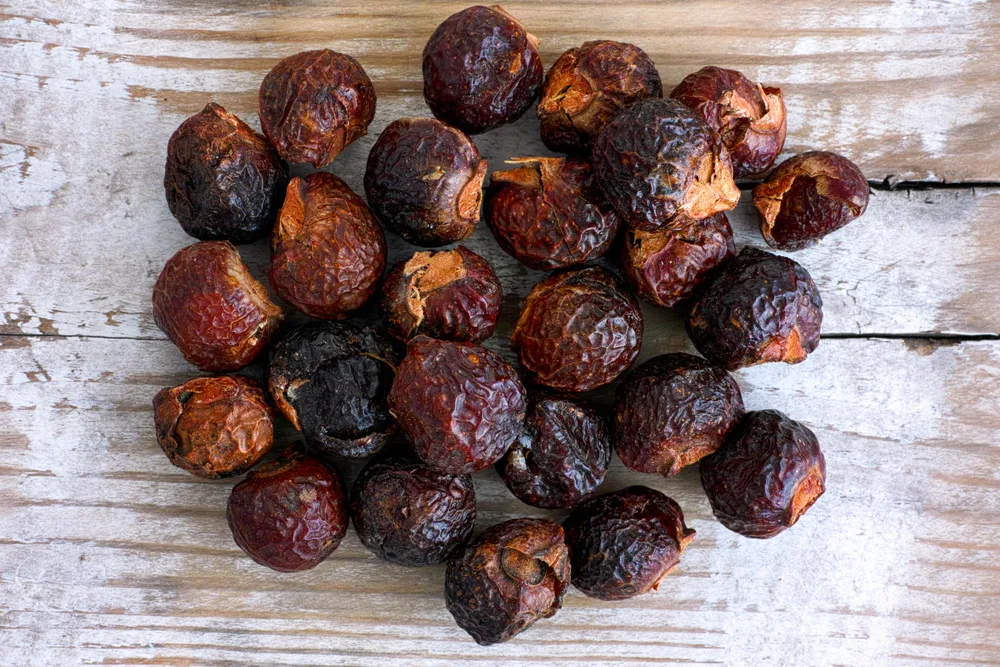
Native to temperate and tropical regions of the world, the Sapindus genus makes up around a dozen species of trees and shrubs within the Lychee family.
Bearing small, leathery stone fruits, soap nuts have been used as a natural cleanser for many millennia in India, China, and the Americas.
The sun dried fruit from Indian Soapberry (Sapindus mukorossi) are available to purchase online.
We recommend this USDA certified organic 1 pound bag from Cocoboo that includes a cloth wash bag.
There are also a couple Sapindus varieties native to the southern US. If you live in hardiness zone 9 to 11, try growing Florida Soapberry (Sapindus marginatus) or Wingleaf Soapberry (Sapindus saponaria) for your very own soap nut supply.
Benefits of Using Soap Nuts
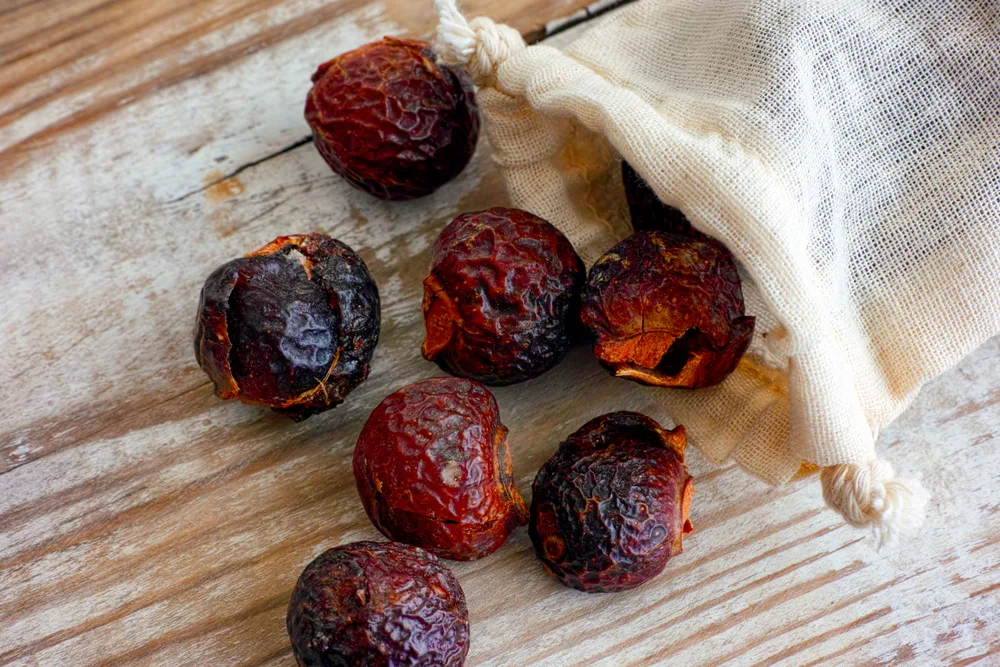
The reasons to swap out your regular household cleansers for soap nuts are numerous:
It’s Earth Friendly
Soap nuts literally grow on trees and so are a renewable resource that require very little processing with no plastic packaging.
Once spent, they are completely biodegradable and can be tossed into your compost heap.
Soap nut suds rinsed down the drain won’t pollute water systems either.
It’s All Natural
Soap nuts are scentless, hypoallergenic, and free of chemical additives and fragrance. They are also incredibly gentle on the skin, clothing, and household surfaces.
It’s not actually a nut either, so those with nut allergies are safe to use it.
It’s Super Economical
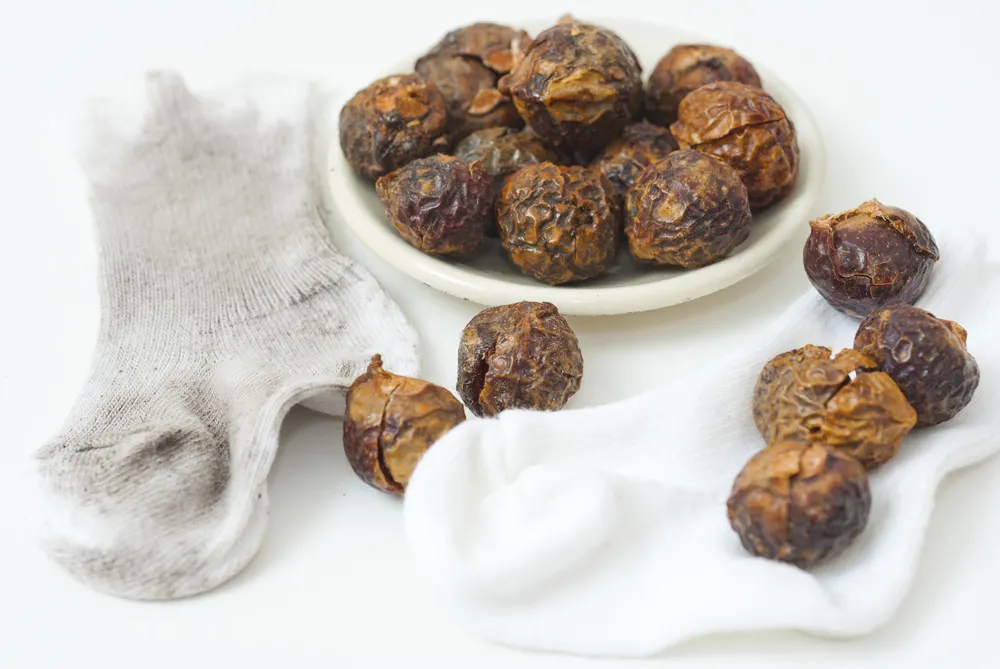
Soap nuts can replace many different cleansers around the home. And since they can be reused up to six times, a little soap nut goes a long way.
An example: compared with laundry detergents that cost around $0.25 per load, soap nuts will do the job for just $0.07 per load!
Simple to Use
At its most basic, soap nuts only need water and a little agitation to work their cleaning magic.
They work just as well in cold or hot water. You can use them in any kind of washer, including front loading HE machines.
Soap nuts naturally soften fabrics too, eliminating the need for dryer sheets.
How to Use Soap Nuts
1. Laundry Soap
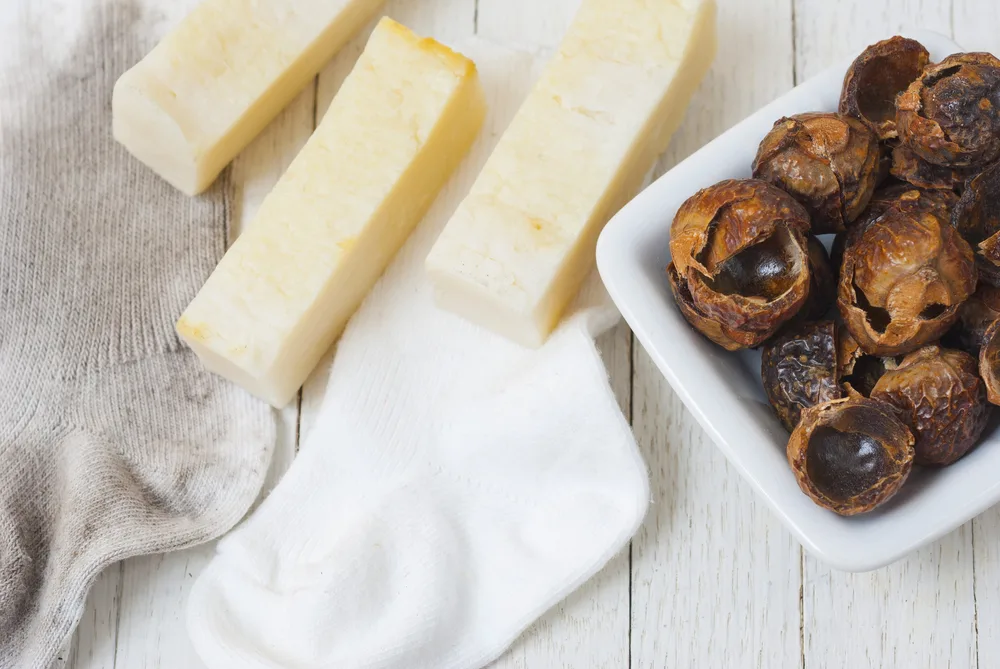
Most people begin their soap nut journey by using it as laundry detergent.
To start, simply drop a few nuts into a cloth bag (or even an old sock), tie it off and toss it in the washer to replace liquid or powdered detergent as well as fabric softener.
When washing in hot water, add two soap nuts to the bag. If washing in cold water, add four nuts to the bag. Reuse these soap nuts up to six times.
Although soap nuts are scent free and produce a fresh but neutral aroma on clothing, you can always add a few drops of your favorite essential oil to the bag for a headier fragrance.
Add vinegar or baking soda to the wash when cleaning white garments or stained clothing.
When the washing is complete, hang up the sachet to dry completely between uses. This step helps prevent rot or mold from developing on the soap nuts.
To test whether your previously used soap nuts still have their soapy lather, drop them into a small container with water. Screw on the lid and give it a good shake. If it’s sudsy, the soap nuts are still good to use. If there’s no foam, it’s time to toss them in the compost bin.
Alternatively, you can use soap nuts in liquid or powdered form too!
2. Liquid Soap
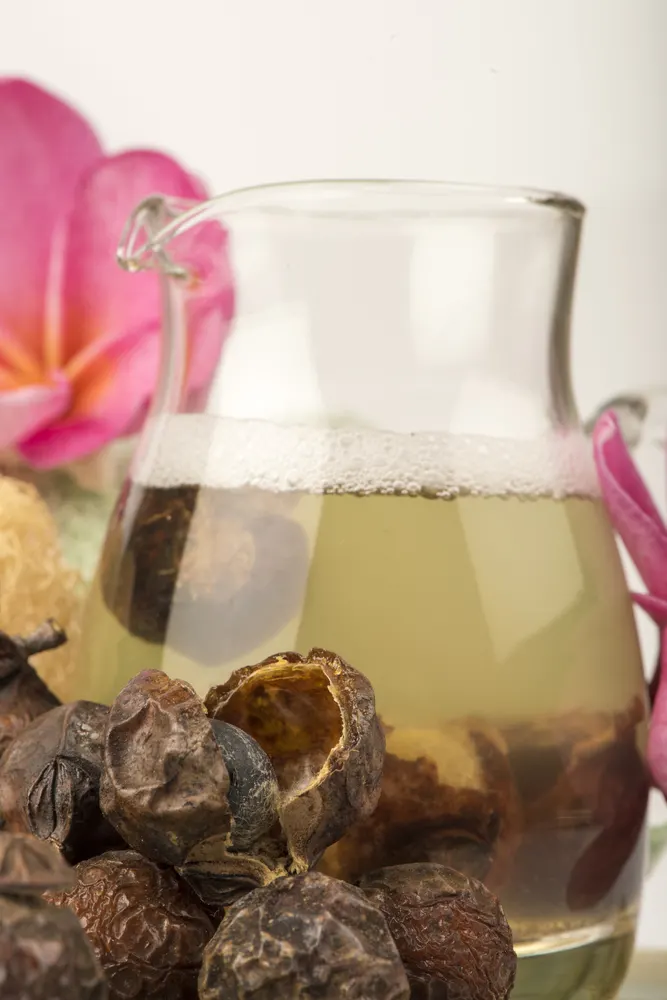
To make soap nuts a way more versatile cleaning agent, it’s easy to render them into a liquid.
You’ll need:
- 15 soap nuts
- 6 cups of water
- Glass jar with a lid
Pour water into a pot and bring to a boil.
Sterilize your glass jar and lid by placing them in boiling water for at least 10 minutes. Place a clean dish towel on your countertop and with a jar lifter or tongs, carefully pick up the container and set it on the dish towel to cool.
With a fresh pot of boiling water, add the soap nuts. Boil for about 30 minutes, topping up water as it evaporates. Mash up the soap nuts as they soften to release the fleshy pulp from the shell.
Remove from heat and allow to cool before straining the liquid into the sterilized jar. Screw on the lid snugly and store in the refrigerator.
Since soap nuts are a fruit, they will spoil in time. This liquid soap will keep in the fridge for about 2 weeks. For an even longer storage life, pour the liquid into an ice cube tray and freeze.
3. Powdered Soap
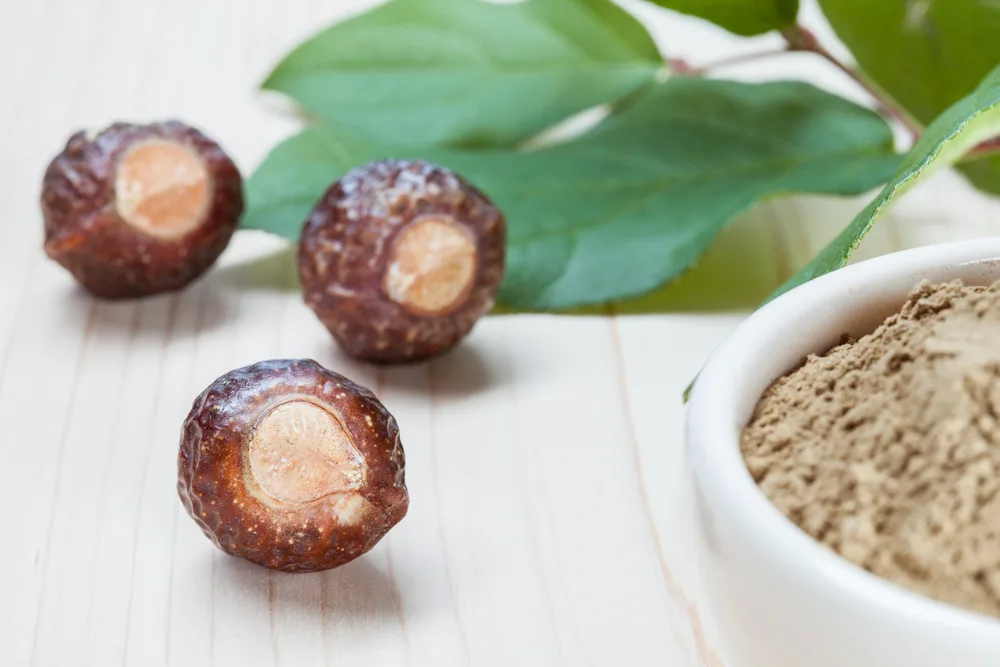
It’s easy to make soap nuts into a powder too. The trick is to ensure it’s really finely ground up with no discernible bits.
Use a coffee or spice grinder to reduce them into a powder with a flour-like consistency.
You can also buy soap nut powder if you’d rather.
4. Dishwashing Soap
For squeaky clean dishware, pour some soap nut powder into your dishwasher’s detergent receptacle.
Another option is to place four soap nuts in a cloth bag and tuck it into the cutlery tray. When the cycle is complete, always hang up the soap nut bag to dry before using it again.
For hand washed dishes, just add a squirt of liquid soap nuts to a sink of warm water and stir it up to create some good suds.
5. All Purpose Cleaner
To make a spray for cleaning multiple surfaces around the home, add ½ cup of liquid soap nuts, 2 tablespoons of white vinegar, and ¼ cup of water to a spray bottle.
Use this solution to spritz and wipe down countertops, sinks, appliances, tubs, toilets, cabinets, doors, floors, stainless steel, porcelain, wood, and more.
6. Glass Cleaner
For streak free windows and mirrors, combine 1 tablespoon liquid soap nuts, 2 tablespoons of white vinegar, and ½ cup of water and transfer to a spray bottle. Use paper towels or newspaper to buff and shine.
This mixture is particularly effective for dirty exterior glass, grease marks, oily handprints, and toothpaste splatter on bathroom mirrors.
7. Scouring Powder
Great for scrubbing toilet bowls, tubs, and shower walls, make a paste by mixing together ¼ cup of Borax, ¼ cup baking soda, and ½ cup of liquid soap nuts.
Stir until you get the consistency you like. Add a bit of water if you prefer a thinner mix.
8. Jewelry and Silverware Polish
Restore tarnished silver by soaking it in tub of liquid nut soap diluted in distilled water. Let it sit in the liquid for about 20 minutes before scrubbing and polishing with a soft bristled toothbrush.
9. Shampoo
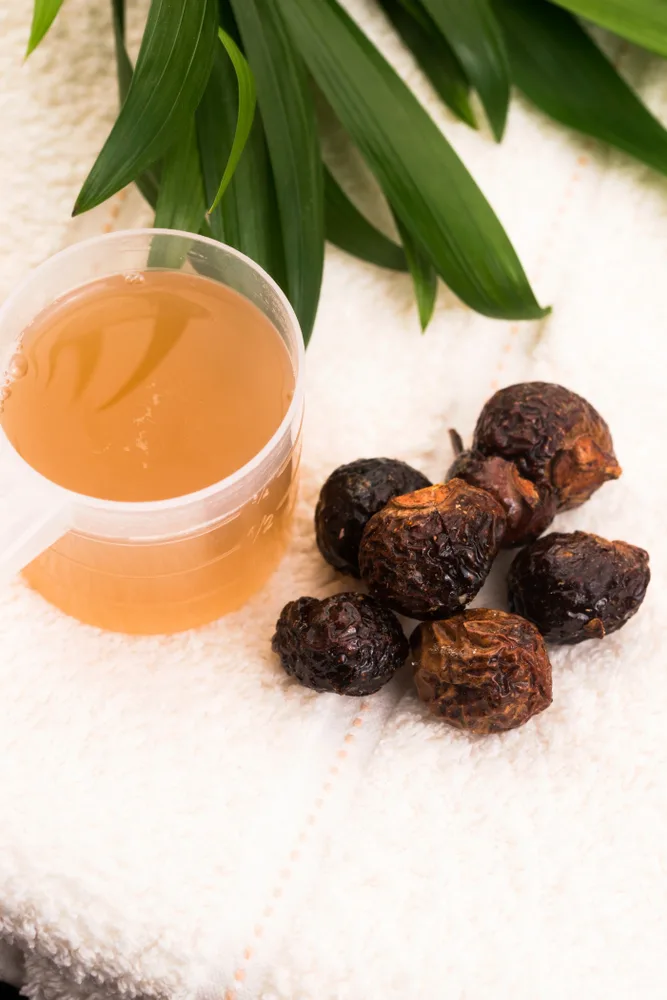
For a gentle hair and scalp cleanser, apply a quarter sized dollop of liquid soap nuts to your head. Massage and lather deeply into your scalp and rinse well.
Finish with a white vinegar rinse for the softest tresses ever.
10. Face and Body Wash
Similarly, add a squirt of the liquid to a wash cloth or loofah to clean and exfoliate your skin.
11. Pet Care
With a cleaning action that is mild enough for our furry friends, use liquid soap nuts for pet shampoo, cleaning toys, and washing bedding.
12. Car Wash
You can feel good about washing your car on your driveway with soap nuts – the biodegradable soap that won’t harm the ecosystem!
Soak 8 to 12 whole soap nuts in a bucket of hot water for about 30 minutes, or dilute a few squirts of liquid in water and use straight away.
13. Fruit and Vegetable Wash
Get rid of any nasties fresh produce may have picked up in transit by spritzing your fruits and veggies with liquid soap nuts.
Once sprayed, rub the suds into all nooks and crannies and rinse well.
14. Insecticide
Saponins have surfactant properties that are naturally antimicrobial, and it is this quality that makes soap nuts such a great cleaner.
In plants, saponins are produced as a defensive mechanism to protect the plant from attacks by microbes, fungi, and feeding from animals.
Saponins are toxic to insects and have been used with success as a pest control for food crops and stored grains.
To protect your garden from harmful insects, dilute some liquid soap nuts into a spray bottle and mist your plants. Repeat weekly and after each rainfall.
Where To Buy Soap Nuts
Soap nuts are a versatile, relatively inexpensive natural product that deserve a place in every home.
They are rapidly rising in popularity, which means you may find them in your mainstream grocery store down the laundry aisle, but if not you can buy soap nuts online.
This 1 pound bag of USDA certified organic soap nuts from Cocoboo available on Amazon is our top pick.
Here are some more options available on Amazon:

Get the famous Rural Sprout newsletter delivered to your inbox.
Including Sunday musings from our editor, Tracey, as well as “What’s Up Wednesday” our roundup of what’s in season and new article updates and alerts.


